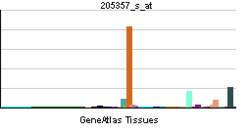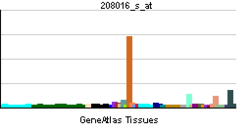Angiotensin II receptor type 1
| View/Edit Human | View/Edit Mouse |
Angiotensin II receptor, type 1 or AT1 receptor is the best characterized angiotensin receptor. It has vasopressor effects and regulates aldosterone secretion. It is an important effector controlling blood pressure and volume in the cardiovascular system. Angiotensin II receptor antagonists are drugs indicated for hypertension, diabetic nephropathy and congestive heart failure.
Function
The AT1 receptor mediates the major cardiovascular effects of angiotensin II. Effects include vasoconstriction, aldosterone synthesis and secretion, increased vasopressin secretion, cardiac hypertrophy, augmentation of peripheral noradrenergic activity, vascular smooth muscle cells proliferation, decreased renal blood flow, renal renin inhibition, renal tubular sodium reuptake, modulation of central sympathetic nervous system activity, cardiac contractility, central osmocontrol and extracellular matrix formation.[4]
Mechanism
The angiotensin receptor is activated by the vasoconstricting peptide angiotensin II. The activated receptor in turn couples to Gq/11 and thus activates phospholipase C and increases the cytosolic Ca2+ concentrations, which in turn triggers cellular responses such as stimulation of protein kinase C. Activated receptor also inhibits adenylate cyclase and activates various tyrosine kinases.[5]
Clinical significance
The AT1 receptor may play role in the generation of reperfusion arrhythmias following restoration of blood flow to ischemic or infarcted myocardium.
The AT1 receptor has also been implicated in post-traumatic stress disorder,[6]
Animal studies
AT1 receptor antagonists have been shown to reduce fear memory recall in mice.[7][8]
Gene
It was previously thought that a related gene, denoted as AGTR1B, existed; however, it is now believed that there is only one type 1 receptor gene in humans. At least four transcript variants have been described for this gene. Additional variants have been described but their full-length nature has not been determined. The entire coding sequence is contained in the terminal exon and is present in all transcript variants.[9]
Interactions
Angiotensin II receptor type 1 has been shown to interact with Zinc finger and BTB domain-containing protein 16.[10] The protein's mRNA has been reported to interact with Mir-132 microRNA as part of an RNA silencing mechanism that reduces receptor expression.[11]
References
- ↑ "Drugs that physically interact with Type-1 angiotensin II receptor view/edit references on wikidata".
- ↑ "Human PubMed Reference:".
- ↑ "Mouse PubMed Reference:".
- ↑ Catt KJ, Mendelsohn FA, Millan MA, Aguilera G (1984). "The role of angiotensin II receptors in vascular regulation". Journal of Cardiovascular Pharmacology. 6 Suppl 4 (Suppl 4): S575–86. doi:10.1097/00005344-198406004-00004. PMID 6083400.
- ↑ Higuchi S, Ohtsu H, Suzuki H, Shirai H, Frank GD, Eguchi S (Apr 2007). "Angiotensin II signal transduction through the AT1 receptor: novel insights into mechanisms and pathophysiology". Clinical Science. 112 (8): 417–28. doi:10.1042/CS20060342. PMID 17346243.
- ↑ Khoury NM, Marvar PJ, Gillespie CF, Wingo A, Schwartz A, Bradley B, Kramer M, Ressler KJ (Jun 2012). "The renin-angiotensin pathway in posttraumatic stress disorder: angiotensin-converting enzyme inhibitors and angiotensin receptor blockers are associated with fewer traumatic stress symptoms". The Journal of Clinical Psychiatry. 73 (6): 849–55. doi:10.4088/JCP.11m07316. PMC 4087173
 . PMID 22687631.
. PMID 22687631. - ↑ Marvar PJ, Goodman J, Fuchs S, Choi DC, Banerjee S, Ressler KJ (Jun 2014). "Angiotensin type 1 receptor inhibition enhances the extinction of fear memory". Biological Psychiatry. 75 (11): 864–72. doi:10.1016/j.biopsych.2013.08.024. PMC 3975818
 . PMID 24094510.
. PMID 24094510. - ↑ Hurt RC, Garrett JC, Keifer OP, Linares A, Couling L, Speth RC, Ressler KJ, Marvar PJ (Sep 2015). "Angiotensin type 1a receptors on corticotropin-releasing factor neurons contribute to the expression of conditioned fear(1)". Genes, Brain, and Behavior. 14 (7): 526–33. doi:10.1111/gbb.12235. PMID 26257395.
- ↑ "Entrez Gene: AGTR1 angiotensin II receptor, type 1".
- ↑ Senbonmatsu T, Saito T, Landon EJ, Watanabe O, Price E, Roberts RL, Imboden H, Fitzgerald TG, Gaffney FA, Inagami T (Dec 2003). "A novel angiotensin II type 2 receptor signaling pathway: possible role in cardiac hypertrophy". The EMBO Journal. 22 (24): 6471–82. doi:10.1093/emboj/cdg637. PMC 291832
 . PMID 14657020.
. PMID 14657020. - ↑ Elton TS, Kuhn DE, Malana GE, Martin MM, Nuovo GJ, Pleister AP, Feldman DS (2007). "MiR-132 Regulates Angiotensin II Type 1 Receptor Expression Through a Protein Coding Region Binding Site". Circulation. 118 (18): S513.
Further reading
- Matsusaka T, Ichikawa I (1997). "Biological functions of angiotensin and its receptors". Annual Review of Physiology. 59: 395–412. doi:10.1146/annurev.physiol.59.1.395. PMID 9074770.
- Allen AM, Moeller I, Jenkins TA, Zhuo J, Aldred GP, Chai SY, Mendelsohn FA (Sep 1998). "Angiotensin receptors in the nervous system". Brain Research Bulletin. 47 (1): 17–28. doi:10.1016/S0361-9230(98)00039-2. PMID 9766385.
- Berry C, Touyz R, Dominiczak AF, Webb RC, Johns DG (Dec 2001). "Angiotensin receptors: signaling, vascular pathophysiology, and interactions with ceramide". American Journal of Physiology. Heart and Circulatory Physiology. 281 (6): H2337–65. PMID 11709400.
- Arima S, Ito S (Nov 2001). "New insights into actions of the renin-angiotensin system in the kidney: concentrating on the Ang II receptors and the newly described Ang-(1-7) and its receptor". Seminars in Nephrology. 21 (6): 535–43. doi:10.1053/snep.2001.26792. PMID 11709801.
- Stowasser M, Gunasekera TG, Gordon RD (Dec 2001). "Familial varieties of primary aldosteronism". Clinical and Experimental Pharmacology & Physiology. 28 (12): 1087–90. doi:10.1046/j.1440-1681.2001.03574.x. PMID 11903322.
- Padmanabhan N, Padmanabhan S, Connell JM (Dec 2000). "Genetic basis of cardiovascular disease--the renin-angiotensin-aldosterone system as a paradigm". Journal of the Renin-Angiotensin-Aldosterone System. 1 (4): 316–24. doi:10.3317/jraas.2000.060. PMID 11967817.
- Thibonnier M, Coles P, Thibonnier A, Shoham M (2002). "Molecular pharmacology and modeling of vasopressin receptors". Progress in Brain Research. 139: 179–96. doi:10.1016/S0079-6123(02)39016-2. ISBN 978-0-444-50982-6. PMID 12436935.
- Elton TS, Martin MM (Mar 2003). "Alternative splicing: a novel mechanism to fine-tune the expression and function of the human AT1 receptor". Trends in Endocrinology and Metabolism. 14 (2): 66–71. doi:10.1016/S1043-2760(02)00038-3. PMID 12591176.
- Saavedra JM, Benicky J, Zhou J (2007). "Mechanisms of the Anti-Ischemic Effect of Angiotensin II AT( 1 ) Receptor Antagonists in the Brain". Cellular and Molecular Neurobiology. 26 (7-8): 1099–111. doi:10.1007/s10571-006-9009-0. PMID 16636899.
- Oliveira L, Costa-Neto CM, Nakaie CR, Schreier S, Shimuta SI, Paiva AC (Apr 2007). "The angiotensin II AT1 receptor structure-activity correlations in the light of rhodopsin structure". Physiological Reviews. 87 (2): 565–92. doi:10.1152/physrev.00040.2005. PMID 17429042.
- Ariza AC, Bobadilla NA, Halhali A (2007). "[Endothelin 1 and angiotensin II in preeeclampsia]". Revista De Investigación Clínica; Organo Del Hospital De Enfermedades De La Nutrición. 59 (1): 48–56. PMID 17569300.
- Xia Y, Zhou CC, Ramin SM, Kellems RE (Sep 2007). "Angiotensin receptors, autoimmunity, and preeclampsia". Journal of Immunology. 179 (6): 3391–5. doi:10.4049/jimmunol.179.6.3391. PMC 3262172
 . PMID 17785770.
. PMID 17785770. - Mauzy CA, Hwang O, Egloff AM, Wu LH, Chung FZ (Jul 1992). "Cloning, expression, and characterization of a gene encoding the human angiotensin II type 1A receptor". Biochemical and Biophysical Research Communications. 186 (1): 277–84. doi:10.1016/S0006-291X(05)80804-6. PMID 1378723.
- Curnow KM, Pascoe L, White PC (Jul 1992). "Genetic analysis of the human type-1 angiotensin II receptor". Molecular Endocrinology. 6 (7): 1113–8. doi:10.1210/me.6.7.1113. PMID 1508224.
- Furuta H, Guo DF, Inagami T (Feb 1992). "Molecular cloning and sequencing of the gene encoding human angiotensin II type 1 receptor". Biochemical and Biophysical Research Communications. 183 (1): 8–13. doi:10.1016/0006-291X(92)91600-U. PMID 1543512.
- Takayanagi R, Ohnaka K, Sakai Y, Nakao R, Yanase T, Haji M, Inagami T, Furuta H, Gou DF, Nakamuta M (Mar 1992). "Molecular cloning, sequence analysis and expression of a cDNA encoding human type-1 angiotensin II receptor". Biochemical and Biophysical Research Communications. 183 (2): 910–6. doi:10.1016/0006-291X(92)90570-B. PMID 1550596.
- Bergsma DJ, Ellis C, Kumar C, Nuthulaganti P, Kersten H, Elshourbagy N, Griffin E, Stadel JM, Aiyar N (Mar 1992). "Cloning and characterization of a human angiotensin II type 1 receptor". Biochemical and Biophysical Research Communications. 183 (3): 989–95. doi:10.1016/S0006-291X(05)80288-8. PMID 1567413.
- Gemmill RM, Drabkin HA (1992). "Report of the Second International Workshop on Human Chromosome 3 mapping". Cytogenetics and Cell Genetics. 57 (4): 162–6. doi:10.1159/000133138. PMID 1683828.
- Curnow KM, Pascoe L, Davies E, White PC, Corvol P, Clauser E (Sep 1995). "Alternatively spliced human type 1 angiotensin II receptor mRNAs are translated at different efficiencies and encode two receptor isoforms". Molecular Endocrinology. 9 (9): 1250–62. doi:10.1210/me.9.9.1250. PMID 7491117.
- Marrero MB, Schieffer B, Paxton WG, Heerdt L, Berk BC, Delafontaine P, Bernstein KE (May 1995). "Direct stimulation of Jak/STAT pathway by the angiotensin II AT1 receptor". Nature. 375 (6528): 247–50. doi:10.1038/375247a0. PMID 7746328.
External links
- "Angiotensin Receptors: AT1". IUPHAR Database of Receptors and Ion Channels. International Union of Basic and Clinical Pharmacology.
This article incorporates text from the United States National Library of Medicine, which is in the public domain.

